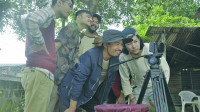Entertainment
Revisiting Nepali basketry
The exhibit showcases signature weaving traditions of various ethnic groups
Sakchham Karki
An art exhibition, titled Contemporary Nepali Basketry, that features an array of hand-woven baskets created by Nepali women from a variety of ethnicities is currently on display at the Siddhartha Art Gallery in the Capital.
The exhibit is organised by Fiber Weave, a subsidiary of Nepal Knotcraft Center Private Limited.
Notable for showcasing diverse artwork that boast signature weaving traditions of various ethnic groups, the featured artists had put out their artwork working under the mentorship of artist Shyam Badan Shrestha, during a workshop. To create
the artworks on display the artists worked with various raw materials such as Papyrus, bamboo, Kans, Sisal fibre, and water hyacinth fiber, among others.
Speaking to the Post about the artwork on display, artist Shrestha said, “These artifacts are still woven using traditional methods; but minute alterations in the design and process give them a contemporary feel and make much more efficient than traditional ones.”
She further states that, as their products created with modern techniques, make them resistant to termite, fungus and humidity.
With the exhibition, the organisers, Nepal Knotcraft Centre, aim to preserve indigenous crafts and fuse them with modern sensibilities so that they are appealing to a broader range of consumers.
“A number of women across Nepal have already flourishing economically by turning to their roots and creating handicrafts that arre unique to their communities,” Shrestha went on, “As the process of weaving such baskets has no negative impacts to the environment, a host of environmentalists have also supported the exhibit.”
She further added, “Woven articles are entrenched in Nepali culture and lifestyle, and in almost every part of Nepal, woven utensils can be found. But since more and more synthetic fibers make their way into our daily lives, their usage are seeing a slow decline. “Hopefully, this exhibition will make people aware that, if young people are interested in this art and if there is participation from the concerned stakeholders, we can even export these artifacts at premium prices.”
The exhibit will continue until October 28.




 23.12°C Kathmandu
23.12°C Kathmandu










